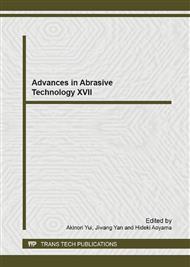p.15
p.21
p.27
p.33
p.38
p.44
p.50
p.55
p.61
Multi-Hole Drilling Method by Abrasive Blasting for CFRP and Composite Materials: Investigation of a Processing Model Based on Abrasive Erosion Phenomenon
Abstract:
Composite materials, such as CFRP, are hard-to-cut materials but their specific strength is useful. Drill tools are usually used to generate small holes of 1-2 mm diameter, but tool abrasion occurs early, causing problems of processing costs. Comparing other processing methods, it was revealed in the previous report that it was possible to effectively generate large quantities of small size holes using blasting. However, there have been many unknown mechanisms about this blast processing. In the present report, we investigated the material-removing mechanisms of the blast from the viewpoint of the erosion abrasion, considering the most suitable method through changing work materials and processing conditions such as abrasive and pressure.
Info:
Periodical:
Pages:
38-43
Citation:
Online since:
September 2014
Keywords:
Price:
Сopyright:
© 2014 Trans Tech Publications Ltd. All Rights Reserved
Share:
Citation:


